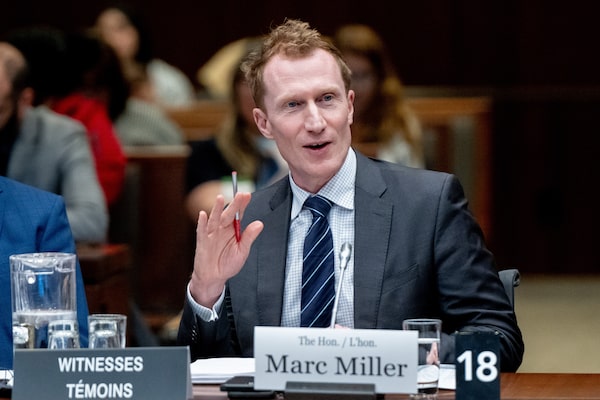
Marc Miller, Minister of Immigration, Refugees and Citizenship, waits to appear before the Standing Committee on Citizenship and Immigration in Ottawa, on March 20.Spencer Colby/The Canadian Press
The federal government is planning to rein in the number of temporary residents and restrict how many foreign workers businesses can hire, after months of warnings, including from economists, that escalating numbers are putting pressure on housing and health care.
Immigration Minister Marc Miller said Thursday that as a first step, the government plans to reduce the proportion of temporary residents in the population from 6.2 per cent to 5 per cent over the next three years. It means that the temporary resident population would decrease by about 19 per cent.
The move marks a shift in direction for the federal government, which has long touted high immigration as an economic stimulant that would counter an aging society and fill jobs.
Temporary residents have largely driven the rapid growth of the population over the past year. There are now 2.5 million temporary residents, a number that includes asylum seekers, international students and people here on work permits.
Mr. Miller said in an interview that these residents “are indispensable to the health of our economy, but also our social fabric.” But, he said, “it’s undeniable that … the increase of numbers has contributed to the impact on affordability, particularly in the cost of shelter, but also the carry-on effects this can have on the health care system, in the education system.”
He said that for the first time beginning this fall, Ottawa plans to set targets for the number of temporary residents it will allow, alongside those it already sets for permanent residents.
This fall’s target will be finalized after talks with provinces about their labour needs, he said. Quebec, in particular, has expressed concern about the rising number of asylum seekers.
Employment Minister Randy Boissonnault detailed plans Thursday to reduce the number of temporary foreign workers, except in key sectors such as construction and health care.
Mr. Boissonnault said he wanted employers to make greater efforts to hire from the pool of talent already in the country.
“The Temporary Foreign Worker Program is a last resort. We expect businesses to exhaust every option and work to prioritize workers in Canada before applying for temporary foreign workers,” he said. “Employers should not use the Temporary Foreign Worker Program as a means to avoid offering competitive wages to Canadians.”
According to Statistics Canada, 1.2 million people were unemployed as of February, while around 400,000 others wanted work but weren’t actively looking for a job. The number of job vacancies has fallen to roughly 637,000 from peak levels of one million in the spring of 2022.
Canada’s population shock drives most of recent productivity declines
Starting May 1, employers in four sectors will see a reduction in the share of their work force that they can hire through the low-wage stream of the Temporary Foreign Worker Program – to 20 per cent from 30 per cent. Hospitals, nursing and residential care facilities and construction companies will be exempt.
The 30-per-cent cap was previously set to expire on Aug. 30.
Mr. Boissonnault also announced changes to hiring foreign workers through Labour Market Impact Assessments (LMIA), which businesses can apply for if there is no Canadian available to do a job. Once an employer obtains an LMIA from Employment and Social Development Canada, the foreign worker can apply for a work permit.
Immigration consultants and lawyers have warned about abuse of the LMIA system, with some foreign workers being asked to pay thousands of dollars to clinch a job in Canada.
Mr. Miller told The Globe there were certain “integrity challenges” with the LMIA program. Mr. Boissonnault said he wanted to stamp out abuse of the system.
He also announced changes that will mean LMIAs would be valid for six months, down from 12 months. Also, employers will need to consider asylum seekers in Canada with valid work permits for positions before applying for an LMIA.
In the spring of 2022, the federal government made a significant expansion of the Temporary Foreign Worker Program, aimed at helping companies that were struggling to find workers. Most employers were allowed to hire up to 20 per cent of their staff from the low-wage stream, up from 10 per cent.
However, employers in seven hard-hit sectors – such as food manufacturing and hospitality – were granted a temporary 30-per-cent limit.
After those moves, companies greatly expanded their recruitment of foreign workers through the TFW program’s low-wage stream, according to government figures. And while some employers will see their access to foreign labour curtailed in the coming weeks, the 20-per-cent cap remains higher than before the pandemic.
Mr. Miller said that the overall 5-per-cent target for temporary residents would not affect Canada’s policy of accepting refugees, and people fleeing war zones such as Ukraine and Gaza.
He said discussions with provinces about levels of temporary residents would include the availability of accommodation for foreign workers.
He also announced plans to increase the number of “draws” that would provide more temporary residents with a route to permanent residency.
Bloc Québécois Leader Yves-François Blanchet welcomed Mr. Miller’s commitment to hold talks with Quebec. He told reporters in the Commons that a big concern for the province is the growing number of asylum claimants.
Earlier this month, Prime Minister Justin Trudeau rebuffed Quebec’s request for additional powers over immigration, saying the province has more control over its newcomers than any jurisdiction in Canada.
Premier François Legault had asked Mr. Trudeau at a meeting in Montreal for full control over immigration.
Quebec Immigration Minister Christine Fréchette said in a statement Thursday that the Ottawa announcement was “a first step.”
“Our welcome capacity has reached its limit, and our public services are under too much pressure,” she said.
Benjamin Tal, deputy chief economist at CIBC, who has briefed the cabinet about the pressure on housing from the influx of temporary foreign residents, said the announcement was “a move in the right direction.”
“While additional supply measures are clearly needed, moves on the demand side of the equation such as this work much faster to ease the pressure on housing demand, mainly rental,” he said.
Mikal Skuterud, a professor of economics at the University of Waterloo, said the changes marked “an unambiguous shift in direction” for the government.
Canada’s population has been growing more quickly than other G7 countries, with migration accounting for most of the increase. Real gross domestic product per capita – a popular measure of living standards – has fallen to multi-year lows as the economy stagnates but the population rises quickly.
The Bank of Montreal’s senior economist Robert Kavcic said in a note to clients Thursday that the changes could have an impact on Canada’s population.
“If these targets are met, while net births and permanent resident inflows continue as planned, we judge that Canadian population growth could grind down closer to 1% in the coming years from north of 3% today,” he wrote.
 Matt Lundy
Matt Lundy